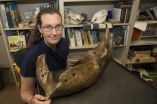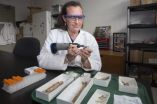(Press-News.org) Their scruffy beards weren't ironic, but there are reasons mammoths and mastodons could have been the hipsters of the Ice Age.
According to research from the University of Cincinnati, the famously fuzzy relatives of elephants liked living in Greater Cincinnati long before it was trendy – at the end of the last ice age. A study led by Brooke Crowley, an assistant professor of geology and anthropology, shows the ancient proboscideans enjoyed the area so much they likely were year-round residents and not nomadic migrants as previously thought.
They even had their own preferred hangouts. Crowley's findings indicate each species kept to separate areas based on availability of favored foods here at the southern edge of the Last Glacial Maximum's major ice sheet.
"I suspect that this was a pretty nice place to live, relatively speaking," Crowley says. "Our data suggest that animals probably had what they needed to survive here year-round."
COULD THE PAST SAVE THE FUTURE?
Crowley's research with co-author and recent UC graduate Eric Baumann, "Stable Isotopes Reveal Ecological Differences Among Now-Extinct Proboscideans from the Cincinnati Region, USA," was recently published in Boreas, an international academic research journal.
Learning more about the different behaviors of these prehistoric creatures could benefit their modern-day cousins, African and Asian elephants. Both types are on the World Wildlife Fund's endangered species list. Studying how variable different types of elephants might have been in the past, Crowley says, might help ongoing efforts to protect these largest of land mammals from continued threats such as poaching and habitat destruction.
"There are regionally different stories going on," Crowley says. "There's not one overarching theme that we can say about a mammoth or a mastodon. And that's becoming more obvious in studies people are doing in different places. A mammoth in Florida did not behave the same as one in New York, Wyoming, California, Mexico or Ohio."
THE WISDOM IN TEETH
For their research, Crowley and Baumann looked to the wisdom in teeth – specifically museum specimens of molars from four mastodons and eight mammoths from Southwestern Ohio and Northwestern Kentucky. Much can be revealed by carefully drilling a tooth's surface and analyzing the stable carbon, oxygen and strontium isotopic signatures in the powdered enamel.
Each element tells a different story. Carbon provides insight into an animal's diet, oxygen relates to overall climatic conditions of an animal's environment and strontium indicates how much an animal may have traveled at the time its tooth was forming.
"Strontium reflects the bedrock geology of a location," Crowley says. "So if a local animal grows its tooth and mineralizes it locally and dies locally, the strontium isotope ratio in its tooth will reflect the place where it lived and died. If an animal grows its tooth in one place and then moves elsewhere, the strontium in its tooth is going to reflect where it came from, not where it died."
Their analysis allowed them to determine several things:
Mammoths ate more grasses and sedges than mastodons, which favored leaves from trees or shrubs.
Strontium from all of the animals (except one mastodon) matched local water samples, meaning they likely were less mobile and migratory than previously thought.
Differences in strontium and carbon between mammoths and mastodons suggest they didn't inhabit the same localities.
Mammoths preferred to be closer to the retreating ice sheet where grasses were more abundant, whereas mastodons fed farther from the ice sheet in more forested habitat.
"As a geologist, questioning the past is one of the most interesting and exciting things to do," says Baumann, an environmental geologist with a contractor for the U.S. Environmental Protection Agency. "Based on our data, mammoths and mastodons seemed to have different diets and lived in different areas during their lives. This is important because it allows us to understand how species in the past lived and interacted. And the past is the key to the present."
Crowley of the McMicken College of Arts and Sciences plans further research into how strontium isotopes can be used to explore megafauna, including other projects dealing with mammoths and mastodons.
INFORMATION: END
Mammoth and mastodon behavior was less roam, more stay at home
UC research on mammoths and mastodons could benefit modern-day elephants
2014-07-21
ELSE PRESS RELEASES FROM THIS DATE:
NIH-supported scientists demonstrate very early formation of SIV reservoir
2014-07-21
WHAT:
Scientists have generally believed that HIV and its monkey equivalent, SIV, gain a permanent foothold in the body very early after infection, making it difficult to completely eliminate the virus even after antiretroviral therapy has controlled it. Now NIH-supported researchers report that SIV can become entrenched in tissues fewer than 3 days after infection, before the virus is detectable in blood plasma (the liquid part) or blood cells.
Led by Dan H. Barouch, M.D., Ph.D., of Beth Israel Deaconess Medical Center and the Ragon Institute, in collaboration with ...
National survey from AP-NORC examines perceptions of health care provider quality
2014-07-21
Chicago, July 20, 2014—The Associated Press-NORC Center for Public Affairs Research has released the results of a major survey examining the public's opinions about what it means to be a quality health care provider in the United States. The survey, funded by the Robert Wood Johnson Foundation, sheds new light on how American adults perceive the quality of their health care and doctors, as well as the information they use and trust when making health care decisions. The survey produces new and actionable data during a crucial period of Affordable Care Act (ACA) implementation. ...
Try, try again? Study says no
2014-07-21
CAMBRIDGE, MA -- When it comes to learning languages, adults and children have different strengths. Adults excel at absorbing the vocabulary needed to navigate a grocery store or order food in a restaurant, but children have an uncanny ability to pick up on subtle nuances of language that often elude adults. Within months of living in a foreign country, a young child may speak a second language like a native speaker.
Brain structure plays an important role in this "sensitive period" for learning language, which is believed to end around adolescence. The young brain is ...
Fires and Smoke in Canada's Northern Territories
2014-07-21
Environment Canada has issued a high health risk warning for Yellowknife and surrounding area because of heavy smoke in the region due to forest fires. Currently 160 wildfires are burning across the region. There are no plans for evacuation since these fires are endangering people or property. Weather that has been hitting the area recently comes with mixed results. The rains help to dampen the fires, but the lightning tends to start others.
This year the Northern Territories have seen 855,000 hectares (over 2,100,000 acres) burned as opposed to the territories 10 ...
Researchers provide guide to household water conservation
2014-07-21
BLOOMINGTON, Ind. -- Want to conserve water and save on your utility bill? A paper co-written by an Indiana University researcher and published in the current issue of the journal Environment can help.
"The Water Short List: The Most Effective Actions U.S. Households Can Take to Curb Water Use" describes how households can reduce water use substantially by simple actions such as installing more efficient appliances and changing day-to-day habits involving water consumption. While the suggestions may be familiar, the researchers are the first to put a comprehensive, quantitative ...
Penn study: Understanding graphene's electrical properties on an atomic level
2014-07-21
Graphene, a material that consists of a lattice of carbon atoms, one atom thick, is widely touted as being the most electrically conductive material ever studied. However, not all graphene is the same. With so few atoms comprising the entirety of the material, the arrangement of each one has an impact on its overall function.
Now, for the first time, researchers from the University of Pennsylvania have used a cutting-edge microscope to study the relationship between the atomic geometry of a ribbon of graphene and its electrical properties.
A deeper understanding of ...
Louisiana Tech University professor presents at International Bioprinting Congress
2014-07-21
RUSTON, La. – Dr. Mark DeCoster, the James E. Wyche III Endowed Professor in Biomedical Engineering at Louisiana Tech University, will present as an invited speaker at the International Bioprinting Congress, July 24-25 at the Biopolis Research and Development Center in Singapore.
DeCoster, who is also a research faculty member in Louisiana Tech's Institute for Micromanufacturing, will present a lecture titled, "Bioprinting interfaces for 2D and 3D cell and tissue models." The presentation will focus on the development of a novel, matrix-free method for generating 3D ...
UCI researchers find epigenetic tie to neuropsychiatric disorders
2014-07-21
Irvine, Calif., July 21, 2014 — Dysfunction in dopamine signaling profoundly changes the activity level of about 2,000 genes in the brain's prefrontal cortex and may be an underlying cause of certain complex neuropsychiatric disorders, such as schizophrenia, according to UC Irvine scientists.
This epigenetic alteration of gene activity in brain cells that receive this neurotransmitter showed for the first time that dopamine deficiencies can affect a variety of behavioral and physiological functions regulated in the prefrontal cortex.
The study, led by Emiliana Borrelli, ...
Transiting exoplanet with longest known year
2014-07-21
Astronomers have discovered a transiting exoplanet with the longest known year. Kepler-421b circles its star once every 704 days. In comparison, Mars orbits our Sun once every 780 days. Most of the 1,800-plus exoplanets discovered to date are much closer to their stars and have much shorter orbital periods.
"Finding Kepler-421b was a stroke of luck," says lead author David Kipping of the Harvard-Smithsonian Center for Astrophysics (CfA). "The farther a planet is from its star, the less likely it is to transit the star from Earth's point of view. It has to line up just ...
Communication about female condom vital to young adults, UT Arlington researchers say
2014-07-21
The female condom is one of just two barrier methods that can protect against sexually transmitted infections and unplanned pregnancies, yet many young adults are not aware of the device, a new study by two UT Arlington researchers has found.
They say the reason could lie in the way information about the female condom is communicated to young people.
Charla Markham Shaw, associate professor of communication, and Karishma Chatterjee, an assistant professor of communication studies in The University of Texas at Arlington College of Liberal Arts, co-authored the paper "Communicating ...
LAST 30 PRESS RELEASES:
URI researchers uncover molecular mechanisms behind speciation in corals
Chitin based carbon aerogel offers a cleaner way to store thermal energy
Tracing hidden sources of nitrate pollution in rapidly changing rural urban landscapes
Viruses on plastic pollution may quietly accelerate the spread of antibiotic resistance
Three UH Rainbow Babies & Children’s faculty elected to prestigious American Pediatric Society
Tunnel resilience models unveiled to aid post-earthquake recovery
Satellite communication systems: the future of 5G/6G connectivity
Space computing power networks: a new frontier for satellite technologies
Experiments advance potential of protein that makes hydrogen sulfide as a therapeutic target for Alzheimer’s disease
Examining private equity’s role in fertility care
Current Molecular Pharmacology achieves a landmark: real-time CiteScore advances to 7.2
Skeletal muscle epigenetic clocks developed using postmortem tissue from an Asian population
Estimating unemployment rates with social media data
Climate policies can backfire by eroding “green” values, study finds
Too much screen time too soon? A*STAR study links infant screen exposure to brain changes and teen anxiety
Global psychiatry mourns Professor Dan Stein, visionary who transformed mental health science across Africa and beyond
KIST develops eco-friendly palladium recovery technology to safeguard resource security
Statins significantly reduce mortality risk for adults with diabetes, regardless of cardiovascular risk
Brain immune cells may drive more damage in females than males with Alzheimer’s
Evidence-based recommendations empower clinicians to manage epilepsy in pregnancy
Fungus turns bark beetles’ defenses against them
There are new antivirals being tested for herpesviruses. Scientists now know how they work
CDI scientist, colleagues author review of global burden of fungus Candida auris
How does stroke influence speech comprehension?
B cells transiently unlock their plasticity, risking lymphoma development
Advanced AI dodel predicts spoken language outcomes in deaf children after cochlear implants
Multimodal imaging-based cerebral blood flow prediction model development in simulated microgravity
Accelerated streaming subgraph matching framework is faster, more robust, and scalable
Gestational diabetes rose every year in the US since 2016
OHSU researchers find breast cancer drug boosts leukemia treatment
[Press-News.org] Mammoth and mastodon behavior was less roam, more stay at homeUC research on mammoths and mastodons could benefit modern-day elephants






